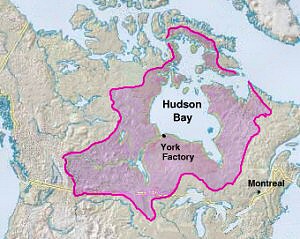Browse "Exploration"
-
Article
Rupert’s Land (Plain-Language Summary)
Rupert's Land was a vast area of northern wilderness; it covered about a third of what is now Canada. From 1670 to 1870, it was controlled by the Hudson’s Bay Company (HBC), which ran the fur trade there. The area was named after Prince Rupert, the first governor of the HBC. In 1870, just after Canada became a country, the government bought Rupert’s Land from the HBC. The purchase changed Canada, making it a large nation stretching across North America. Rupert's Land was eventually divided among the provinces of Quebec, Ontario, Manitoba, Saskatchewan and Alberta, and the Northwest Territories. (This article is a plain-language summary of Rupert’s Land. If you are interested in reading about this topic in more depth, please see our full-length entry, Rupert’s Land.)
"https://d2ttikhf7xbzbs.cloudfront.net/PrinceRupert/hudson_bay_ruperts_land.jpg" // resources/views/front/categories/view.blade.php
https://d2ttikhf7xbzbs.cloudfront.net/PrinceRupert/hudson_bay_ruperts_land.jpg
-
Article
South Sea Company
South Sea Company was chartered in 1711 by the British Parliament. It had a monopoly over the West coast of the Americas to a distance of 300 leagues out to sea.
"https://development.thecanadianencyclopedia.ca/images/tce_placeholder.jpg?v=e9dca980c9bdb3aa11e832e7ea94f5d9" // resources/views/front/categories/view.blade.php
https://development.thecanadianencyclopedia.ca/images/tce_placeholder.jpg?v=e9dca980c9bdb3aa11e832e7ea94f5d9
-
Article
Spanish Exploration
Following the global circumnavigation of Magellan's expedition, 1519-22, Holy Roman Emperor Charles V wished to locate a N American strait into Asian waters. The Spaniards possessed information on the Newfoundland and Labrador coasts from Portuguese voyages and from BASQUE fishermen and whalers.
"https://development.thecanadianencyclopedia.ca/images/tce_placeholder.jpg?v=e9dca980c9bdb3aa11e832e7ea94f5d9" // resources/views/front/categories/view.blade.php
https://development.thecanadianencyclopedia.ca/images/tce_placeholder.jpg?v=e9dca980c9bdb3aa11e832e7ea94f5d9
-
Article
Sutil and Mexicana
In 1792, after exploratory voyages by Spaniards Manuel Quimper (1790) and Francisco de Eliza (1791), the extent of Juan de Fuca Strait remained a mystery. Some still believed the strait held the entry to the fabled Northwest Passage.
"https://development.thecanadianencyclopedia.ca/images/tce_placeholder.jpg?v=e9dca980c9bdb3aa11e832e7ea94f5d9" // resources/views/front/categories/view.blade.php
https://development.thecanadianencyclopedia.ca/images/tce_placeholder.jpg?v=e9dca980c9bdb3aa11e832e7ea94f5d9
-
Article
The Principall Navigations, Voyages and Discoveries of the English Nation
The Principall Navigations, Voyages and Discoveries of the English Nation was written by Richard Hakluyt (c 1552-1616). A passionate enthusiast of trade and colonization, convinced that English navigators "excelled all ...
"https://development.thecanadianencyclopedia.ca/images/tce_placeholder.jpg?v=e9dca980c9bdb3aa11e832e7ea94f5d9" // resources/views/front/categories/view.blade.php
https://development.thecanadianencyclopedia.ca/images/tce_placeholder.jpg?v=e9dca980c9bdb3aa11e832e7ea94f5d9
-
Editorial
The Northwest Passage: From Myth to Reality
The following article is an editorial written by The Canadian Encyclopedia staff. Editorials are not usually updated.
"https://development.thecanadianencyclopedia.ca/images/tce_placeholder.jpg?v=e9dca980c9bdb3aa11e832e7ea94f5d9" // resources/views/front/categories/view.blade.php
https://development.thecanadianencyclopedia.ca/images/tce_placeholder.jpg?v=e9dca980c9bdb3aa11e832e7ea94f5d9
-
Article
Trading Post
The trading post can be viewed as a large household whose size and social organization reflected the cultural heritage of its members and the post's role in the fur trade.
"https://d2ttikhf7xbzbs.cloudfront.net/media/media/a4d6e476-5e53-4126-9ee6-313b64235660.jpg" // resources/views/front/categories/view.blade.php
https://d2ttikhf7xbzbs.cloudfront.net/media/media/a4d6e476-5e53-4126-9ee6-313b64235660.jpg
-
Article
Travels and Adventures in Canada and the Indian Territories between the Years 1760 and 1776
Travels and Adventures in Canada and the Indian Territories between the Years 1760 and 1776 (New York, 1809; Toronto, 1901) was written by Alexander Henry (the elder), one of the first Britons to venture into western Indigenous territory after the defeat of the French at Québec.
"https://development.thecanadianencyclopedia.ca/images/tce_placeholder.jpg?v=e9dca980c9bdb3aa11e832e7ea94f5d9" // resources/views/front/categories/view.blade.php
https://development.thecanadianencyclopedia.ca/images/tce_placeholder.jpg?v=e9dca980c9bdb3aa11e832e7ea94f5d9
-
Editorial
Voyage of the Nonsuch: A Turning Point in the Fur Trade
The following article is an editorial written by The Canadian Encyclopedia staff. Editorials are not usually updated.At some point in the 1650s, two adventurers from New France embarked on a journey that eventually revolutionized the fur trade and changed the course of Canadian history.
"https://development.thecanadianencyclopedia.ca/images/tce_placeholder.jpg?v=e9dca980c9bdb3aa11e832e7ea94f5d9" // resources/views/front/categories/view.blade.php
https://development.thecanadianencyclopedia.ca/images/tce_placeholder.jpg?v=e9dca980c9bdb3aa11e832e7ea94f5d9
-
Article
Voyageurs
Voyageurs were independent contractors, workers or minor partners in companies involved in the fur trade. They were licensed to transport goods to trading posts and were usually forbidden to do any trading of their own. The fur trade changed over the years, as did the groups of men working in it. In the 17th century, voyageurs were often coureurs des bois — unlicensed traders responsible for delivering trade goods from suppliers to Indigenous peoples. The implementation of the trading licence system in 1681 set voyageurs apart from coureurs des bois, who were then considered outlaws of sorts. Today, the word voyageur, like the term coureur des bois, evokes the romantic image of men canoeing across the continent in search of furs. Their life was full of perilous adventure, gruelling work and cheerful camaraderie.
"https://d2ttikhf7xbzbs.cloudfront.net/media/media/50d0c290-345d-4655-b501-3cfa471dfdb7.jpg" // resources/views/front/categories/view.blade.php
https://d2ttikhf7xbzbs.cloudfront.net/media/media/50d0c290-345d-4655-b501-3cfa471dfdb7.jpg
